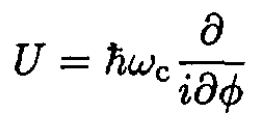
n = 2 Hydrogen with Electric and Magnetic Fields
 المؤلف:
Sidney B. Cahn, Gerald D. Mahan And Boris E. Nadgorny
المؤلف:
Sidney B. Cahn, Gerald D. Mahan And Boris E. Nadgorny
 المصدر:
A GUIDE TO PHYSICS PROBLEMS
المصدر:
A GUIDE TO PHYSICS PROBLEMS
 الجزء والصفحة:
part 2 , p 69
الجزء والصفحة:
part 2 , p 69
 19-8-2016
19-8-2016
 1397
1397
n = 2 Hydrogen with Electric and Magnetic Fields
Consider an electron in the n = 2 state of the hydrogen atom. We ignore relativistic corrections, so the 2s and 2p states are initially degenerate. Then we impose two simultaneous perturbations: an electric field E in the x-direction  and a magnetic field B, which is given by the vector potential A = (B/2)(-y, x, 0). Ignore the magnetic moment of the electron. Calculate how the n = 0 states are altered by these simultaneous perturbations.
and a magnetic field B, which is given by the vector potential A = (B/2)(-y, x, 0). Ignore the magnetic moment of the electron. Calculate how the n = 0 states are altered by these simultaneous perturbations.
SOLUTION
The four orbital states: the s-state is |00⟩ and the three p-orbitals are |1 -1⟩, |10⟩, |11⟩. Here again, spin is not affected by this perturbation. We must evaluate the 10 different matrix elements ⟨LM|V(z)|L'M'⟩ which occur in the symmetric 4 × 4 matrix.
One interaction potential is V = -e|E|x. One can use parity and other group theory arguments to show that the only nonzero matrix elements are
 (1)
(1)
 (2)
(2)
One can show that ζ and ζ' are equal to within a phase factor. We ignore this phase factor and call them equal. The evaluation of this integral was demonstrated in the previous solution. The result here is compared to the one in the previous problem.
compared to the one in the previous problem.
To first order in the magnetic field, the interaction is given by
 (3)
(3)
In spherical coordinates the three unit vectors for direction are
In these units the vector potential can be written as  Similarly, the momentum operator in this direction is
Similarly, the momentum operator in this direction is
 (4)
(4)
 (5)
(5)
 (6)
(6)
where the cyclotron frequency is ωc = eB/mc. The magnetic field is a diagonal perturbation in the basis |LM⟩.
Now the state|10⟩ has no matrix elements for these interactions and is unchanged by these interactions to lowest order. So we must diagonalize the 3 × 3 interaction matrix for the three states |00⟩, |11⟩, |1 – 1⟩:
 (7)
(7)
 (8)
(8)
 الاكثر قراءة في مواضيع اخرى
الاكثر قراءة في مواضيع اخرى
 اخر الاخبار
اخر الاخبار
اخبار العتبة العباسية المقدسة


